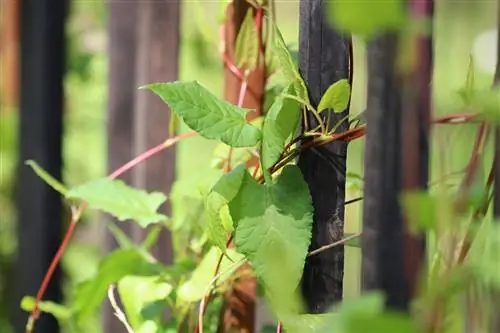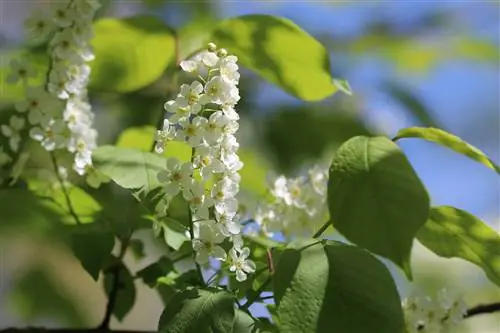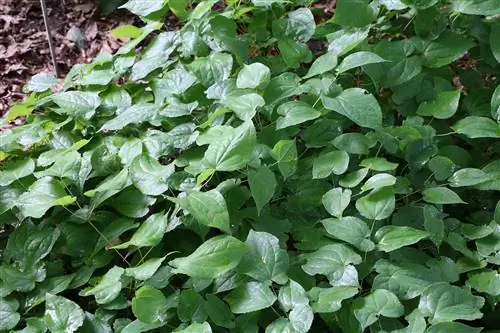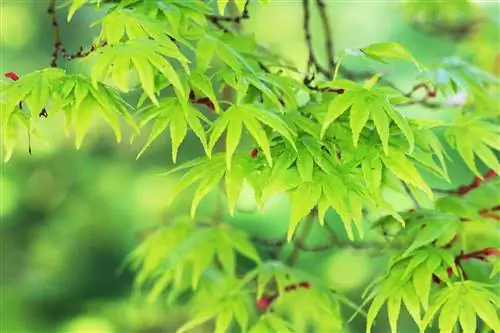- Author admin [email protected].
- Public 2023-12-17 03:39.
- Last modified 2025-01-24 12:45.
Climbing knotweed is a plant that attracts bees because of its many flowers and therefore belongs in every natural garden. Due to the rapid reproduction, special attention must be paid to care.
Profile
- Fallopia aubertii, also Fallopia baldschuanica or Polygonum aubertii
- Knotweed family (Polygonaceae)
- climbing plant
- Growth height up to fifteen meters
- Growth up to six meters
- growing twining and sprawling
- white, yellow or pink flowers on panicles
- exude a light, pleasant scent
- Flowering period from June to October
- deciduous in autumn
Soil texture
Knotweed is quite undemanding when it comes to substrate. This is how normal garden soil can be used here:
- normal, moist soil
- everything from alkaline to acidic is tolerated
- Avoid waterlogging
- loose firm soil with gravel or sand
- Put drainage in the planting hole
- insert a layer of gravel or stone here
Note:
Due to its strong growth, the plant is also popularly called “architect's consolation”, as it completely covers an unsightly facade and therefore the optical defects can no longer be seen here.
Flowering time
In these latitudes, knotweed blooms from June to October, and continuously. Therefore, the plant is also a very good pasture for bees. In addition, the sight of the flowers is enchanting all summer long:
- white, pink or yellow flowers
- on grape-like panicles
- pleasant scent
Tip:
The plant attracts many insects, not just bees, thanks to its flowers and fragrant scent. Therefore, you should not cultivate them in the immediate vicinity of your seat in the garden or directly next to the terrace.
Fertilizing and watering
Especially in the first time after planting and during long dry periods, the plant needs a lot of water and should be watered regularly and very thoroughly.
There's not much to consider when fertilizing either:
- Compost is completely sufficient
- once a year in spring
- fold carefully
- a permanent layer of mulch provides further fertilization
- Soil doesn't dry out so quickly
Tip:
Especially in winter, during long dry periods, it is important that you water the plant enough. A plant can dry out even in winter. However, you should only give water here on frost-free days.
Remove
One thing is certain, knotweed is always harder to remove than to plant and care for. Because it can be difficult if the plant has grown large and has to be removed from a house wall or wall:
- Roots reach several meters into the ground
- radically cut back all new shoots
- Take a trellis from the wall
- cut directly close to the ground at the base
- dig up the entire ground
- remove all roots
- alternatively use a herbicide
- Be careful when there are other plants nearby
- not recommended in a private garden
Note:
The mechanical removal of knotweed requires a lot of effort, time and work. It takes up to five years to finally destroy the entire plant. Above all, the roots must be removed, otherwise the plant will keep sprouting from below.
Diseases and pests
Diseases are virtually unknown in creeping knotweed. If brown leaves appear, it is usually due to a lack of water. Some pests can occur:
- Aphids
- dry times spider mites
- fighting is not necessary
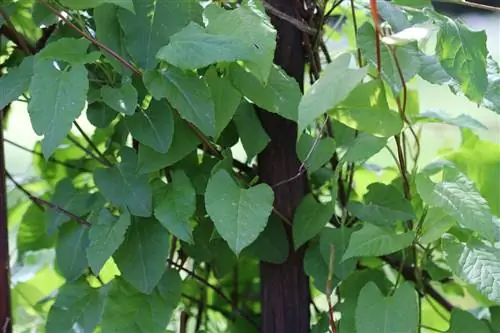
Container cultivation
If you just want to keep the knotweed small, you can also cultivate the plant in a large bucket, such as a large wine barrel. If the long roots don't have as much space, then the entire plant doesn't grow as tall. However, there are still a few things to consider here:
- Drainage holes in bottom of vessel
- drainage made from gravel or clay balls
- mix normal garden soil with compost
- insert small trellis
- Insert plant
- Press the soil well
- water well
- in winter, cover the pot with brushwood mats
The knotweed in the pot should be radically cut back regularly, otherwise it will grow too big here too. Because of this pruning, repotting into a larger container is usually not necessary. If you fertilize regularly with compost in spring, the plant does not need any fresh soil.
Plants and planting time
The suitable planting times are spring or autumn. If containers of the plant, which is very popular with bees, have been purchased commercially, they can be planted all year round. However, you should make sure that the ground is frost-free:
- Planting hole twice as large as root ball
- if drainage is placed, a little deeper
- keep your distance from several plants
- at least 1, 50 meters
- three meters distance is better
- Attach trellis at the same time
- Insert knotweed
- fill in prepared soil
- press lightly
- water well and cover with mulch
Tip:
If you fail to attach the trellis during or before planting, the rapid and rapid growth of the plant may make it difficult to attach it to a wall afterwards.
Cutting
The creeping knotweed is a very vigorous climbing plant that can overgrow a facade within a few years with the appropriate climbing aid. If you don't want it to grow so big and wide, regular cutting is needed:
- Plant tends to go bald
- radical pruning possible
- should take place in autumn
- then the shoots are without leaves
- will sprout he althily again in spring
- regular pruning in February or March
- more often if necessary
- Plant can penetrate every crack with fine shoots
- also grows over the roof without cutting
Note:
When you cut the knotweed, you don't have to be squeamish. Because the plant sprouts again quickly and cannot be stopped by a radical cut down to the base.
Location
When choosing a location, the first thing to pay attention to is the strong, fast-spreading growth. However, removing it if the location is not suitable will be very difficult. An old house wall or wall is therefore particularly suitable for knotweed. Fallopia aubertii does not place any great demands on the location. In general, it is important to have a climbing aid so that the plant can wind itself to the sides and upwards:
- sunny to partially shaded location
- shade is also tolerated
- on an east, west or north side of the house
- A south wall, on the other hand, is rather unsuitable
- rain-protected location
- ideally a wall under an eaves
- on an arbor or pergola
- Substructure must be sufficiently stable
Tip:
Avoid planting the plant on low sheds or garden sheds, as such a low building will be completely overgrown within a very short time. Trees or rose arches as growth aids are also definitely not recommended.
Wintering
Knotweed is generally hardy. It loses its leaves in autumn and only the long tendrils remain. However, in a very harsh winter, where there are very high temperatures below zero for a long time, the tendrils can partially freeze. If these frozen shoots are cut back, rapid and he althy new growth will occur.
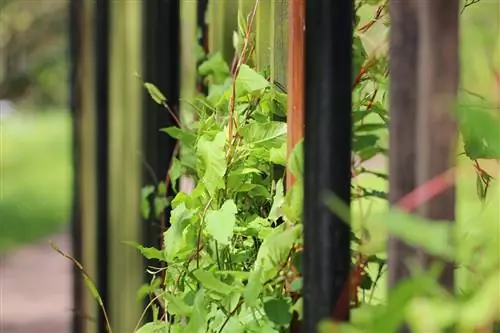
Propagate
Propagation is achieved both through cuttings, which can be taken in February, and through cuttings, which grow herbaceously in summer and are treated in the same way as the bare shoots:
- in February before budding
- cut cuttings about 10 centimeters long
- Those that are not yet woody are suitable for multiplying
- herbaceous offshoots in summer
- Dip the interface in rooting powder
- in potting soil about one centimeter deep
- keep moist
- Put the pot in a warm and sunny location
The roots form after about three to four weeks. Then the cuttings can simply be planted in the desired location.

